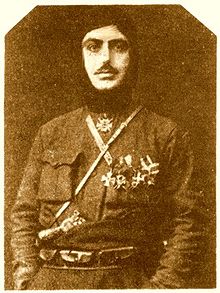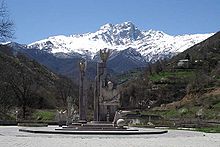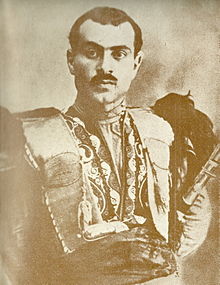- Garegin Nzhdeh
-
Garegin Ter-Harutyunyan 
Commander of the Armenian Army, southern corps In office
August 1919 – July 1921Personal details Born 1 January 1886
Kznut, Nakhichevan, Russian EmpireDied 21 December 1955
Vladimir, Russian SFSR, USSRNationality Armenian Political party Armenian Revolutionary Federation Signature Military service Awards "Cross of Bravery" of Bulgarian Army Garegin Nzhdeh or Garegin Ter-Harutyunyan, Garegin Njdeh (Armenian: Գարեգին Նժդեհ) (1 January 1886, Nakhijevan – 21 December 1955, Vladimir, Soviet Union) was an Armenian statesman, fedayee, political thinker, and, as a member of the A.R.F. Dashnaktsutyun party, was involved in revolutionary activities in Armenia, Bulgaria and Russia, and, as a member of the "Armenian Legion", the armed forces of Nazi Germany.[1][dubious ]
Contents
Biography
Education
Nzhdeh was born on 1 January 1886 in the village of Kznut, Nakhichevan. He was the youngest of four children born to a local village priest. He lost his father, Priest Yeghishe, in his childhood. Njdeh got his early education at a Russian school in Nakhichevan City. He continued his higher education at the Tiflis Russian Gymnasium school. At the age of 17 he joined the Armnenian liberal movement but shortly after, he moved to St. Petersburg to continue his education in the local university. After two years of studying at the Faculty of Law, he left the St. Petersburg University and returned to the Caucasus in order to participate in the Armenian national movements against the Russian and the Ottoman Empires.
In 1906, Njdeh moved to Bulgaria, where he completed his education at the military college in 1907.
Balkan wars
In the same year he returned to Armenia. In 1908 he joined the Armenian Revolutionary Federation and participated in the Iranian revolution along with Yeprem Khan and Murad of Sebastia.
In 1909, upon his return to the Caucasus, Njdeh was arrested by the Russian authorities and spent 3 years in prison. In 1912, together with General Andranik Ozanian, he formed an Armenian battalion within Macedonian-Adrianopolitan Volunteer Corps of the Bulgarian Army to fight against the Ottoman Empire in the Balkan wars, for the liberation of Trakya and Macedonia. During the Second Balkan war he was wounded. For the brave and extraordinary performance of the Armenian fighters, Bulgarian military authorities honoured Njdeh with the "Cross of Bravery".[2]
World War I
Prior to World War I, after an amnesty granted by the Russian authorities in 1914, Njdeh returned to the Caucasus to prepare the formation of the Armenian volunteer units within the Russian army to fight against the Ottoman Empire. During the first stage of the war, in 1915, he was appointed as an assistant-commander to Drastamat Kanayan of the 2nd Armenian unit. Later on, in 1916, he commanded the special Armenian-Yezidi military unit. Arriving in Koghp in 1917 with his small unit, he protected the local Armenian villagers from an imminent attack by the Turkish forces.[citation needed] After the Russian Revolution and the withdrawal of the Russian army, Njdeh fought in the skirmishes of Alajay (near Ani, spring 1918), allowing a secure passage for the retreated Armenian volunteer forces into Alexandrapol.
Battle of Karakilisa
 Njdeh in Armenia
Njdeh in Armenia
After clashing with Turkish forces in Alexandrapol, the Armenian fighters led by Njdeh dug-in and built fortifications in Karakilisa. Njdeh played a key role in organizing the troops for the defense of Karakilisa in May 1918. He managed to mobilize a population of despaired and hopeless locals and refugees for the coming fight through his inspiring speech in the Dilijan church yard, where he called the Armenians to a sacred battle: "Straight to the frontline, our salvation is there". Njdeh was wounded in the ensuing clash and, after a violent battle of 4 days, both sides had serious casualties. The Armenians ran out of ammunition and had to withdraw. Although the Ottoman army managed to invade Karakilisa itself, they had no more resources to continue deeper into Armenian territory.[3]
After the declaration of the independent Democratic Republic of Armenia, Njdeh was appointed governor of Nakhitchevan, and later on, in August 1919, commander of the southern corps of the Armenian army.
Republic of Mountainous Armenia
The Soviet 11th Red Army's invasion of the Democratic Republic of Armenia started on 29 November 1920. Following the sovietization of Armenian on 2 December 2010, the Soviets pledged to take steps to rebuild the army, to protect the Armenians and not to persecute non-communists, although the final condition of this pledge was reneged when the Dashnaks were forced out of the country.
The Soviet Government proposed that the regions of Nagorno-Karabagh and Zangezur (called Syunik in Armenia) should belong to Soviet Azerbaijan. This step was strongly rejected by Nzhdeh. A convinced Anti-Bolshevik, he led the defense of Syunik against the rising Bolshevik movement, who declared Syunik as a self-governing region in December 1920. In January 1921 Drastamat Kanayan sent a telegram to Njdeh, suggesting allowing the sovietization of Syunik, through which they could gain the support of the Bolshevik government in solving the problems of the Armenian lands. As a response, Njdeh did not depart from Syunik and continued his struggle against the Red Army and Soviet Azerbaijan, struggling to maintain the independence of the region.[4][5]
On 18 February 1921, the Dashnaks led an anti-Soviet rebellion in Yerevan and seized power. The ARF controlled Yerevan and the surrounding regions for almost 42 days before being defeated by the numerically superior Red Army troops later in April 1921. The leaders of the rebellion then retreated into the Syunik region.
On 26 April 1921, the 2nd Pan-Zangezurian congress, held in Tatev, announced the independence of the self-governing regions of Daralakyaz (Vayots Dzor), Zangezur, and Mountainous Artsakh, under the name of the Republic of Mountainous Armenia (Lernahaystani Hanrapetutyun).
Following the declaration of independence of the Republic of the Mountainous Armenia from Soviet Armenia, he was proclaimed Prime Minister and Minister of Defense.
Between April and July 1921, the Red Army conducted massive military operations in the region, attacking Syunik from north and the east. After months of fierce battles with the Red Army, the Republic of Mountainous Armenia capitulated in July 1921 following Soviet Russia's promises to keep the mountainous region as a part of Soviet Armenia. After losing the battle, Nzhdeh, his soldiers, and many prominent Armenian intellectuals, including leaders of the first Independent Republic of Armenia, crossed the border into neighboring Persian city of Tabriz.
Organizational activities
After leaving Syunik, Njdeh spent four months in the Persian city of Tabriz. Soon after, he moved to Sofia, Bulgaria where he started a family by marrying Epime, a local Armenian girl and establishing in Bulgaria.
Njdeh was involved in organizational activities in Bulgaria, Romania and the United States through his frequent visits to Plovdiv, Bucharest and Boston.
In 1933, by the decision of ARF Dashnaktsutyun, Njdeh moved to USA along with his partisan, Kopernik Tanterjian. This movement led to the foundation of the Armenian Youth Federation, the youth organization of the Armenian Revolutionary Federation, in Boston, Massachusetts.
He visited several states and provinces in America and Canada, inspiring the Armenian communities that had established themselves there, and founding an Armenian Youth movement called Tseghakron (Armenian: Ցեղակրոն), which later re-named itselft the "Armenian Youth Federation".
In 1937, he was back in Plovdiv, Bulgaria, where he began to publish the "Razmig" Armenian newspaper. At the end of 1930s, along with a group of Armenian intellectuals in Sofia, he founded the Taron Nationalist Movement and published its organ "Taroni Artsiv" paper.
During his life in Bulgaria, Nzhdeh maintained close contacts with revolutionary organizations of Macedonian Bulgarians and Bulgarian Symbolist poet Theodore Trayanov.[6]
Arrest and trial
Because of his inspiration and membership of the "Armenian Legion" within the paramilitary forces of Nazi Germany,[1] Nzhdeh was arrested in Bulgaria in September 1944 by the soldiers of the Soviet Army's special brigade "SMERSH". He was transferred to Bucharest and later to Moscow, where he was held in the Lubyanka prison.
After his arrest, Njdeh's wife and son were sent to exile from Sofia to Pavlikeni.
In November 1946, Njdeh was sent to Yerevan, awaiting trial. At the end of his trial, on 24 April 1948, Njdeh was sentenced to 25 years of imprisonment (to begin in 1944).
Life in prison and death
In 1947 Njdeh proposed an initiative to the Soviet government. It would call for the foundation of a pan-Armenian military and political organization in the Armenian diaspora for the liberation of Western Armenia from Turkish control and its unification to Soviet Armenia. Despite the reputed great interest shown by the communist leaders to this initiative[citation needed], the proposal was eventually refused.
Between 1948-1952 Njdeh was kept in Vladimir prison, then until the summer of 1953 in a secret prison in Yerevan. According to his prison fellow Hovhannes Devedjian, Njdeh's transfer to Yerevan prison was related to an attempt to mediate between the Dashnaks and the Soviet leaders to create a collaborative atmosphere between the two sides. After long negotiations with the state security service of Soviet Armenia, Njdeh and Devejian prepared a letter in Yerevan prison (1953) addressed to the ARF leader Simon Vratsian, calling him for co-operation with the Soviets regarding the issue of the Armenian struggle against Turkey. However, the communist leaders in Moscow refused to send the letter and it only remained a latent document.
After receiving a telegram from the soviet authorities, announcing his death, Njdeh's brother Levon left Yerevan for Vladimir to take care of his burial service. He received Njdeh's watch and clothing but was not allowed to take his personal writings. The authorities also did not allow the transfer his body to Armenia. Levon Ter-Harutiunian conducted Njdeh's burial in Vladimir and wrote on his tombstone in Russian "Ter-Harutiunian Garegin Eghishevich (1886-1955)".
Legacy
 Njdeh Monument in Kapan
Njdeh Monument in Kapan
On 31 August 1983, Njdeh's remains were secretly brought to Soviet Armenia from Vladimir. It was accomplished by the efforts of linguist Varag Arakelyan and Pavel Ananyan, the husband of Njdeh's grand-daughter. On 7 October 1983, only a small part of Njdeh's body (right hand) was placed on the slopes of Mountain Khustup near the Kozni fountain, and -according to participants to the funeral- the rest of the body was kept in the cellar of Varag Arakelyan's country-house until 9 May 1987, when it was secretly buried at the yard of the 14th century Spitakavor Surb Astvatsatsin Church of Yeghegnadzor.
Decades after his death, on 30 March 1992, Njdeh was rehabilitated by the supreme court of the Republic of Armenia.
Njdeh had mentioned in his will that he would like to be buried on the slopes of Mountain Khustup. On 26 April 2005 during the celebration of the 84th anniversary of the Republic of Mountainous Armenia, parts of Njdeh's body were taken from Spitakavor church to Khustup. Thus, Njdeh was reburied for the third time, finally to rest on the slopes of Mountain Khustup at Njdeh's Monument near Kapan.[7]
In March 2010, Njdeh was selected as the "National pride and the most outstanding figure"[8] of the Armenians throughout the history, by the voters of "We are Armenians" TV project launched by "Hay TV" and broadcast as well by the Public Television of Armenia (H1).[9]
An avenue, a large square and a nearby metro station in Yerevan are named after Garegin Nzhdeh.
Njdeh is, without a doubt, an important representative of Armenian history. His inspiring character as a soldier, thinker, orator and politician, make him one of the most outstanding people in the entire history of Armenia.
Quotations from Njdeh
Quotations from Nzhdeh:[10]
1. Even the morally depraved can voice noble principles.
2. Life is constant and endless renewal. Only the morally irresponsible refuse to understand this.
3. Without renewal, a nation dies every hour, every minute. Our political parties either don't understand this or they have no desire to understand it.
4. A nation that fails to do what it can and must do has no right to expect foreign assistance.
5. Nations that are unwilling to defend their own interests condemn themselves to death.
6. When dealing with foreign powers and issues, our press adopts a permissive, forgiving, and subservient tone. With our own internal problems, however, it becomes arrogant, vindictive, vicious.
7. Life is endless renewal. Where there is no renewal there will be spiritual paralysis and a slow death.
8. It is the height of ignorance for a political party to think that it can deny the value of morality in its own conduct and maintain moral integrity within its ranks.
9. To struggle in defense of what is right is not a calamity but a blessing.
10. Undermining the morality of a nation amounts to undermining its strength.
11. Why did I fight against the Soviet Army?! Because they invaded my country alongside with the Turks.
12. To live and strive only for what deserves sacrifice; to sacrifice only for what deserves living for.
Works
- "The Pantheon of Dashnaktsutyun", Alexandrapol 1917
- "Calls of Khustup", Goris 1921
- "My Speech - Why I Fought against the Soviet Army", Bucharest 1923
- "Some Pages from my Diary", Cairo 1924
- "Open Letters to the Armenian Intelligentsia", Sofia 1926 and Beirut 1929
- "The Struggle of Sons against Fathers", Thessaloniki 1927
- "The Motive of the Soul of the Nation", Sofia 1932
- "The American Armenians - The Tribe and its Gutter", Sofia 1935
- "My Answer", Sofia 1937
- "Autobiography", Sofia 1944
- "Thoughts - Notes from Jail", Yerevan 1993
Documentaries about G. Njdeh
Books:
- "The Battle of Lernahayastan", by Vartan Kevorkian, Bucharest 1923
- "Njdeh", by Avo, Beirut 1968
- "The Memories of a Prisoner", by Armen Sevan (Hovhannes Devedjian), Buenos Aires 1970
- "Garegin Njdeh", published in the memory of his 110th anniversary, Yerevan 1996
- "Garegin Njdeh: Analecta", contains Njdeh's ideologies, thoughts, letters, speeches and other writings, Yerevan 2006
- "Njdeh: The Complete Biography", by Rafael Hambardzumian, Yerevan 2007
Movies:
- "The Path of the Eternal" by Arthur Babyan and Armen Tevanian
References
- ^ a b This Land Was Your Land, This Land Was My Land, James Russell
- ^ Македоно-одринското опълчение 1912-1913. Личен състав по документи на Дирекция "Централен военен архив", София 2006, с. 521 (Macedonian-Adrianopolitan Volunteer Corps. Staff according to documents from Directorate Central Military Archives, Sofia 2006, p. 521)
- ^ Hovhanissian, Richard G. (1997) The Armenian People from Ancient to Modern Times. New York. St. Martin's Press, 299
- ^ "Garegin Njdeh biography". Njdeh.com. http://www.njdeh.com/njdehbio.htm. Retrieved 2009-11-19.
- ^ The Armenian Cause Encyclopedia, Yerevan 1996, article:Garegin Njdeh, p. 356
- ^ Михайлов, Иван. Карекин Нъждех, в. Македонска трибуна, г. 31, бр. 1601, 21 ноември 1957 (Mihaylov, Ivan. Garegin Njdeh, Macedonian Tribune, N 1601, 21.11.1957)
- ^ http://www.a1plus.am/en/social/2005/04/28/14478 A1plus.am - NJDEH WAS RE-BURIED. Retrieved 27 April 2005
- ^ http://www.menqhayenq.com/en/Aboutproject Menqhayenq.com - We Are Armenians:About Project
- ^ http://www.menqhayenq.com/en/rating/ Menqhayenq.com - We Are Armenians:Rating
- ^ "Azad Hye Middle East Armenian Portal: Complete biography of Garegin Njdeh published in Yerevan". http://www.azad-hye.net/news/viewnews.asp?newsId=734gjk67.
External links
Armenian Resistance
(late 19th century - early 20th century)1880s - 1900s Bashkale (1889) · Gugunian Expedition (1890) · Kum Kapu (1890) · Sasun (1894) · Zeitun (1895–1896) · Ottoman Bank (1896) · Van (1896) · Khanasor Expedition (1897) · Sasun (1904) · Yıldız assassination attempt (1905)
World War I 1920s Operation Nemesis (1920-1922)Categories:- Armenian resistance
- 1886 births
- 1955 deaths
- Armenian politicians
- Armenian generals
- People from Nakhchivan
- Armenian revolutionaries
- Collaborators with Nazi Germany
Wikimedia Foundation. 2010.





